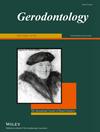Masticatory function and mortality among older adults living in long-term care facilities in Brazil
Abstract
Objective
To investigate the association between mortality and masticatory function in older adults living in long-term care facilities (LTCFs), controlling for demographic and health covariates.
Background
Poor oral health has been associated with mortality; however, no previous study investigated whether objective and self-reported poor masticatory function is a predictor of early mortality in LTCFs.
Materials and Methods
Baseline characteristics of 295 participants were collected, including age, sex, polypharmacy, mobility, activities of daily living, frailty, nutritional status, and objective (masticatory performance – chewing gum) and self-reported masticatory function. The participants were followed-up with for 4 years to record the mortality data. Cox regression models were run to analyse the data (α = .05).
Results
During the 4-year follow-up, 124 (42.0%) participants died. Older adults with poor masticatory performance (hazard ratio [HR] = 1.59, 95% confidence interval [95% CI] = 1.07–2.36) and those who self-reported masticatory dysfunction (HR = 1.48, 95% CI = 1.01–2.16) were at higher risk of early death than those with good mastication. However, in a multivariate model including both objective and self-reported masticatory function, only the objective measurement remained associated with early death (HR = 1.52, 95% CI = 1.02–2.27).
Conclusion
Poor masticatory performance seems to be associated with early death in older adults living in LTCFs, but they may have shared risk factors accumulated throughout life that were not covered by the study period.

 求助内容:
求助内容: 应助结果提醒方式:
应助结果提醒方式:


